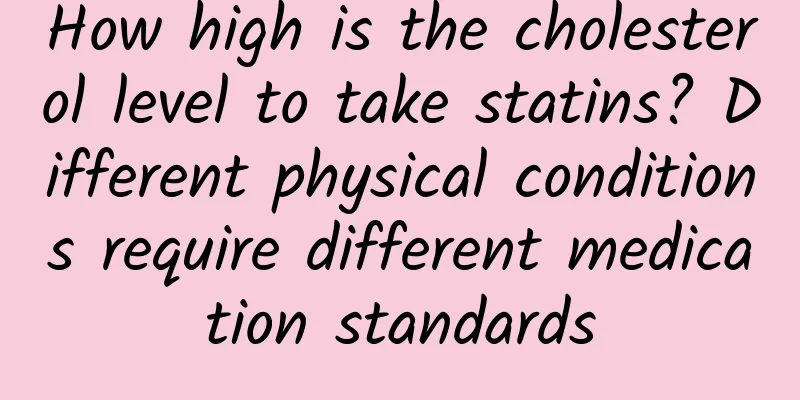How high is the cholesterol level to take statins? Different physical conditions require different medication standards

|
Several friends asked Huazi the same question. They found that their blood lipids were high, but they were undecided about whether to take statins. The upper limit of the normal low-density lipoprotein cholesterol (LDL-C) given on the physical examination form is 3.37mmol/L. Do you have to take medicine if it exceeds the limit? If you need to take medicine, how much should you lower it to? Why do some materials say it should be lowered to 2.6mmol/L, and some say it should be lowered to 1.8mmol/L? Which one is correct? 1. Losing weight cannot reduce blood lipids. Hypertension, high blood sugar, and high blood lipids are collectively called "three highs". People know a lot about blood pressure and blood sugar, and understand the dangers and the need for medication. However, many people do not understand high blood lipids very well, and some people think that blood lipids are the fat in the blood, which is similar to body fat, and can be reduced through dieting, exercise and other weight loss methods. These people are wrong, because although blood lipids are also fat, they cannot be effectively reduced by weight loss. Because the cholesterol in the human body is only 20-30% from dietary intake, and 70-80% is synthesized by the human body. And when the cholesterol intake in the diet decreases, the body's synthesis will increase accordingly. Blood lipids are regulated by the human lipid metabolism system, and humans have not fully understood this metabolic regulation system. In other words, the impact of diet control and exercise on blood lipids is very limited. Many people with normal weight or thin weight may also have high blood lipids. 2. The impact of high blood lipids on the body High blood lipids are very harmful to the human body. The cholesterol level in blood lipids is closely related to the formation and progression of atherosclerosis. The most important indicator is low-density lipoprotein cholesterol (LDL-C), because LDL-C is the main "raw material" for the formation of atherosclerotic plaques. When the LDL-C level in the blood increases, LDL-C will enter the arterial intima to form plaques; when the LDL-C level in the blood decreases, LDL-C can flow back from the arterial intima to the blood. However, most of the LDL-C that enters the arterial intima will be swallowed by macrophages and eventually form foam cells that are deposited in the arterial intima. LDL-C that forms foam cells can no longer flow back into the blood, so once atherosclerotic plaques are formed, they cannot be completely removed. Atherosclerosis is the main cause of cardiovascular and cerebrovascular diseases such as coronary heart disease, myocardial infarction, cerebral infarction, etc., which threaten people's lives, so elevated LDL-C levels must be controlled. 3. How high does cholesterol need to be before you need to take medicine? The reference standard for LDL-C in the blood lipid test on the medical examination form is less than 3.37mmol/L. It should be noted that this is only a reference standard for healthy people without other diseases. Healthy people do not need to rush to take medicine if their blood lipids are not too high. Generally speaking, the standard for healthy people to take medicine is that LDL-C is higher than 4.9mmol/L. For people with chronic diseases, the reference standard for healthy people is not applicable. For people with high blood pressure, diabetes, smoking, and those who have atherosclerosis but have not yet developed cardiovascular and cerebrovascular diseases, the LDL-C control standard is below 2.6mmol/L. If you already have coronary heart disease, or have had a stroke, myocardial infarction or other diseases, you need to prevent the disease from recurring, and the LDL-C control standard is below 1.8mmol/L. For people with a high risk of disease, LDL-C can be further controlled to below 1.4mmol/L. Medically, it is now believed that the lower the LDL-C level, the stronger the protective effect on the cardiovascular system. In related trials, some subjects lowered their LDL-C to around 0.7mmol/L without any adverse effects. There is a saying that if your plaques are not reversed, it means that your LDL-C is not low enough. Statins are the main drugs for controlling LDL-C, because statins can not only lower LDL-C, but also stabilize plaques and prevent plaque rupture. When statins alone cannot achieve the target LDL-C, they can be used in combination with cholesterol absorption inhibitors and PCSK9 inhibitors. To sum up, different physical conditions have different requirements for LDL-C and different medication standards. For healthy people without chronic diseases, there is no need to rush to take medicine if LDL-C is slightly exceeded. Although diet control and exercise have limited effects on blood lipids, a healthy lifestyle has a positive preventive effect on all "three high" chronic diseases and should be adhered to for a long time. If blood lipids are elevated, or if you have other chronic diseases, you need to use drugs to control blood lipids under the guidance of a doctor. I am pharmacist Huazi, welcome to follow me and share more health knowledge. |
<<: What are the benefits of eating dried tofu? How many calories does dried tofu contain?
Recommend
How to avoid Listeria during pregnancy
The refrigerator is a good helper for storing foo...
What to do if you have an itchy throat and cough during early pregnancy
Pregnancy is very hard for women. Not only do the...
What are the signs of breech presentation in late pregnancy?
Breech presentation is generally a malposition of...
Why can 999 silver be attracted by a magnet? What does the N in the magnet stand for? What does the S in the magnet stand for?
Magnets can generate magnetic fields and have the...
Can baby bottles be sterilized by boiling water? What is the best way to sterilize baby bottles?
The milk bottle is the main tool and container fo...
Do you know the treatment of breast fibroids?
Breast fibroids are a type of breast disease. Bre...
How many days after menstruation is over to remove the ring, and when to remove the ring after menstruation
Women should remove the IUD in time after they re...
Will hand expressing breast milk cause my milk to stop flowing?
Women who are breastfeeding usually need to go to...
What are the yoga detox poses during menstruation?
Menstruation is something that every girl has to ...
Can I change the soil for jasmine in dog days? When should I change the soil for jasmine to have a high survival rate?
Jasmine is a very common flower in life. Because ...
What are the precautions for women's physical examination
Physical examination is a health check that every...
How to remove cesarean section scars?
Everyone loves beauty, but women are even more so...
Is it OK to eat hot pot when pregnant?
Eating hot pot is almost the most important eatin...









